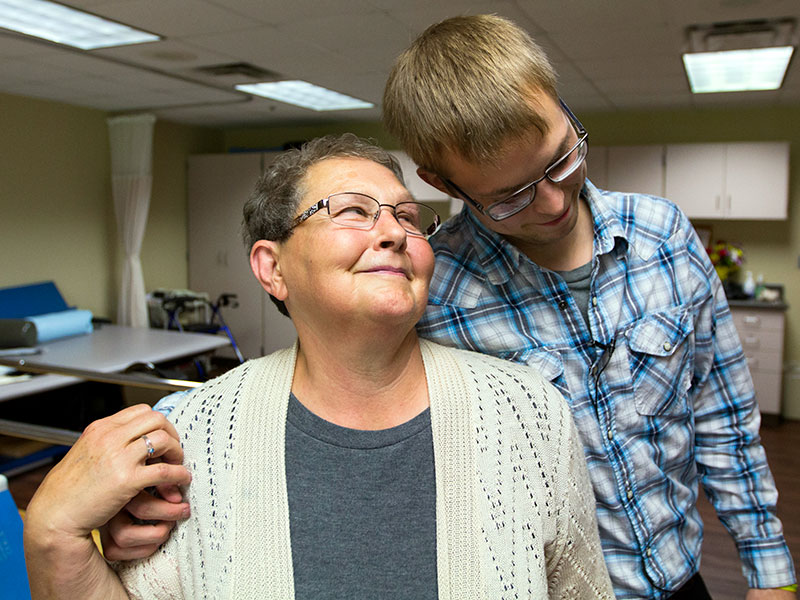Working in a small town nursing home, hospital or health clinic can be both intimidating and encouraging. Two Sanford Health-Good Samaritan Society providers talk about returning to their hometowns as we recognize the annual National Rural Health Day.
Social worker Anissa Hanson-Vis says the benefits outweigh the negatives, particularly when she has the opportunity to catch up with former patients while running errands or shopping in Luverne, Minnesota.
“The good thing about seeing them in the grocery store is that I get to see how they’re doing,” she said. “It’s a touch point. And they get to see that we’re more than just a facility and I’m more than just my job.”
A chance meeting on the street might result in a follow up call when Hanson-Vis returns to work. Her intervention could help prevent rehospitalization for a former short-term rehabilitation patient whose recovery is lagging.
The National Organization of State Offices of Rural Health says one in five Americans — 57 million people — live in rural communities. The organization advocates for access to health care in areas where the number of providers can be limited and the aging population’s needs are growing.
Find a location:
Location, location, location
For patients like Dianne Karlstad, Hanson-Vis said rural health care is all about location.
“It is so helpful that she lives here and her significant other lives here. She has an amazing support group of friends,” Hanson-Vis said. “When you go to the hospital in an emergency, you have no clothes except what you’re wearing. You need someone to bring you the necessities. For Dianne, our rehab facility is less than a mile from her home. They didn’t have to drive an hour to visit her.”
The times the job can feel uncomfortable are the required conversations with long-term residents who were important in her childhood, Hanson-Vis said. When her grandmother lived at Good Samaritan Society – Pipestone where she worked at the time, Hanson-Vis’ role required questions about topics like depression.
“It was great to see her every day, we had an open and honest relationship. But there were times it was difficult.”
And the older women from her church? “They taught me in Sunday school,” Hanson-Vis said. “Gosh how the roles have reversed. And they still have a ton of wisdom to be shared.”
Which Dr. McMillan?
He hasn’t been back in Jamestown, North Dakota, for long but Dr. Rob McMillan has already surprised patients who expected his dad to show up for their colonoscopy. Jamestown doesn’t have a gastroenterology specialist so Rob’s general surgery experience gets him those assignments.
Dad, Dr. Bill McMillan, is a family practice physician. They both work at the Sanford Health Jamestown Second Avenue Clinic.
“It’s a little daunting, living up to my dad’s reputation,” Rob said. “It’s a blessing and a curse because of his name recognition but people also have a certain expectation of me, based on how well they know him.”
Like Hanson-Vis, the social worker in Minnesota, Rob has a growing appreciation for the new relationships he is developing with people he has known most of his life.
“It is interesting to be in Jamestown and to see people in the clinic, and do procedures on people that I’ve known before. The roles in my life have really changed,” he said.
Returning home
During his five-year surgery residency in Milwaukee, Rob started job searching 18 months before graduation. Going home wasn’t his initial plan.
“My wife and I hadn’t really decided and I didn’t know if there would be an opening,” he said. “But when the opportunity came up and I would have a chance to work with my Dad, we were so glad to be moving close to grandparents. This is a good place to raise kids.”
While he might be viewed as a local, Rob said he is new to the community from a surgery standpoint. Potential career support helped seal the deal.
“I would not have come back without that,” Rob said. “Chris Maki really enabled me to come back. He’s my senior partner and mentor.”
Technology and care
Sanford Health, one of the nation’s largest health care systems, serves around 2 million people over 300,000 square miles. Allison Suttle, M.D., Sanford Health’s chief medical officer in Sioux Falls, South Dakota, said technology helps bridge the distance for rural providers and patients.
The organization adopted a single electronic medical record platform, embraced telehealth technologies, developed enterprise-wide departments and committed to data transparency.
“These initiatives and others have helped Sanford Health improve and become a model system for rural health,” she said. “But my take is that these same tactics just might be of value to providers and patients in other settings, including the most urban delivery systems in the country.”
More stories
- Heart screening ‘means my life was saved’
- ‘Staples’ of Sanford Luverne celebrate final clock-out
- Sanford & VA collaborating to vaccinate rural communities
…
Posted In Alexandria, Bemidji, Beresford, Bismarck, Brookings, Canby, Canton-Inwood, Chamberlain, Clear Lake, Detroit Lakes, Dickinson, Digestive Health, Fargo, Grand Forks, Jackson, Jamestown, Luverne, Mayville, Minot, Mitchell, Mountain Lake, Pierre, Rock Rapids, Rural Health, Sheldon, Sioux Falls, Thief River Falls, Tracy, Vermillion, Virtual Care, Wahpeton, Watertown, Webster, Westbrook, Windom, Worthington

